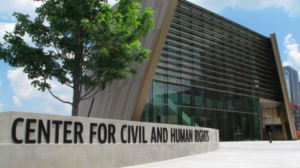
Upon entering the building, after walking past the looming, breathtaking fountains outside, I began to feel butterflies of excitement. It was apparent that this wasn’t one of those museums you were dragged to in elementary school, with the boring and unrelatable exhibits and bored, unattached staff.
The emotions of the place grab you right away. The moment you walked into the first exhibit you were immediately transported into the world of Jim Crow with a “Whites only” wall to the left and a “Blacks only” wall to the right, showcasing pictures of Black and white life. The sounds of several Martin Luther King Jr. speeches played in the background as you began your journey into the recent past.
In the first room there were old television sets with press conferences featuring several segregationists saying things like “we have to protect our children” from integration. One in particular featured Sam Engelhardt, a state senator from Alabama, declaring, “Have no fear, the right and the white will win,” and met with a chorus of cheers.
The opposite wall was lined with speakers. You could pick a button and hear a variety of speeches that the modern day education system doesn’t even come close to mentioning. From MLK’s “Paul’s Letter to American Christians” sermon to Pastor Dr. William Holmes Borders and the Wheat Street Baptist Church’s poem “I’m somebody” celebrating African American achievement, each recording was moving in a way I hadn’t expected.
A wall of actual mugshots of Freedom Riders lined the wall of the next room. There were speakers with over a dozen recordings of personal testimonies from the very people who were on the front line. I noticed the woman next to me crying into a crumpled tissue as she listened to the account of Charles Person, who had ridden from Nashville to Montgomery at 18.
Next to the Freedom Rider exhibit was an experience I hadn’t expected: A simulation of the lunch counter sit ins, intriguing and frightening at the same time. Four diner-style chairs lined a countertop. Once you sat down a screen flashed the words “How Long Will You Last?” in front of you. For the experiment to work, you must close your eyes and place your hands flat on the counter. Once your hands are placed, the timer starts and an onslaught of verbal abuse turns on in your headphones. Hateful screeches of “Get up Boy!” and “I’m gonna kill you right here if you don’t leave” came through the speakers. It was alarming how real it was. The chairs vibrated, adding a physical aspect to the experience. Throughout the whole one minute and 50 second trial, I had to keep whispering to myself that it wasn’t real—despite how I felt at the moment and unlike the people who sat in these chairs a generation ago, I was safe.
Each room was immaculately modeled with a different esthetic from the previous one. There were tissue boxes placed in various places around the March on Washington for Jobs and Freedom room as an emotional video showcased the march and the speeches of that day in 1963.
We made our way through the rest of the exhibits, watching the actual media report when the news of Martin Luther King Jr.’s death broke, then walking through a room of little known martyrs who had given their life for the civil rights movement but never received any acclaim.
Once we made it through the main exhibits, we headed down to the first floor, which housed a room full of handwritten letters to and from MLK. To see his actual handwriting and the documents that were catalysts for so much change was indescribable. These were no longer things you just heard about and read about in dusty old history books. They were right in front of me, tangible and real.
In the wake of last Tuesday’s election, a trip to the National Center for Civil and Human Rights was a breath of fresh air. It was a reminder that none of us can afford to be complacent. The stakes are too high,
The center is open Tuesday through Sunday until 5 p.m. Tickets are $15.
For more information visit http://www.civilandhumanrights.org


